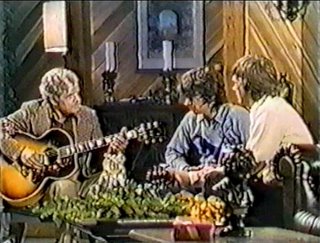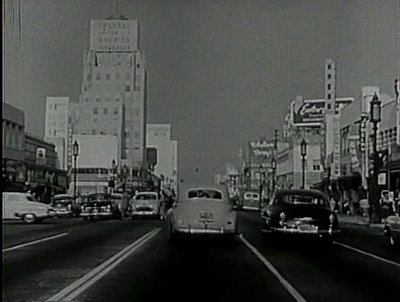
Growing up, there were three heroes in my life. In order of appearance, they were: George Reeves, Johnny Cash and Jack Webb. I discovered all of them via television.
Reeves died tragically 3 and 1/2 months before I was born. Webb died when I was 23. I'd moved to L.A. just nine months before, and had I known he held court daily in a restaurant just a couple of blocks down Sunset from the record store I regularly patronized, I would have marched in there, pen and paper in hand.
Cash I did meet, in 1991; ironically it was on Sunset Blvd. He was appearing briefly at The Guitar Center to put his handprints in cement for the store's "Rock Walk of Fame." This was a couple of years before he signed with Rick Rubin and once more became hip, so there were at best about two dozen fans present at the event.
did meet, in 1991; ironically it was on Sunset Blvd. He was appearing briefly at The Guitar Center to put his handprints in cement for the store's "Rock Walk of Fame." This was a couple of years before he signed with Rick Rubin and once more became hip, so there were at best about two dozen fans present at the event.
I was as nervous as he appeared to be on stage. I shook his hand and stammered "It's a pleasure to meet you," and I think he said "It's a pleasure to meet you, too." Later, after the ceremony, he signed my copy of his first Sun LP. I felt vaguely guilty about that: he'd signed autographs for everyone in the store, and all of them were on old records or books. No one presented any of his recent CDs for a signature. I owned them, and immediately wished I'd brought one. I decided to atone for that sin by buying a ticket to that night's concert at Universal Ampetheatre. It was a good show, what little I recall of it; meeting Cash has pretty much eclipsed all other memories of that day.
Like all heroes, Cash was an inspiration. In my case, he inspired me to pick up a guitar. When The Johnny Cash Show was on the air (1969-71), there was no one with a cooler guitar style. He handled the instrument like a man possessed, playing every inch between the bridge and the nut. I want to play like that, I'd breathe.
And The Johnny Cash Show was the coolest variety program on the air. No ancient crooners, no lame comedy sketches (at least not until the very end of its run) - just great music. There were no boundries on this show. Where else could one see, on the same series, hot country artists like Merle Haggard; vintage Opry people like Homer & Jethro; old and new folkies like Bob Dylan, Joni Mitchell and Gordon Lightfoot; the Everly Brothers jamming with their father, Ike; and even Cash, Carl Perkins and Eric Clapton rocking out on "Matchbox." Clearly, Cash had a deep respect for all kinds of music.

Cash passed away in September 2003. This would have been his 74th birthday. I hope that he, the Carters, Carl, Elvis, Roy and many others are celebrating somewhere on high.
Happy Birthday, Johnny! Thanks for sharing the gift with us!













